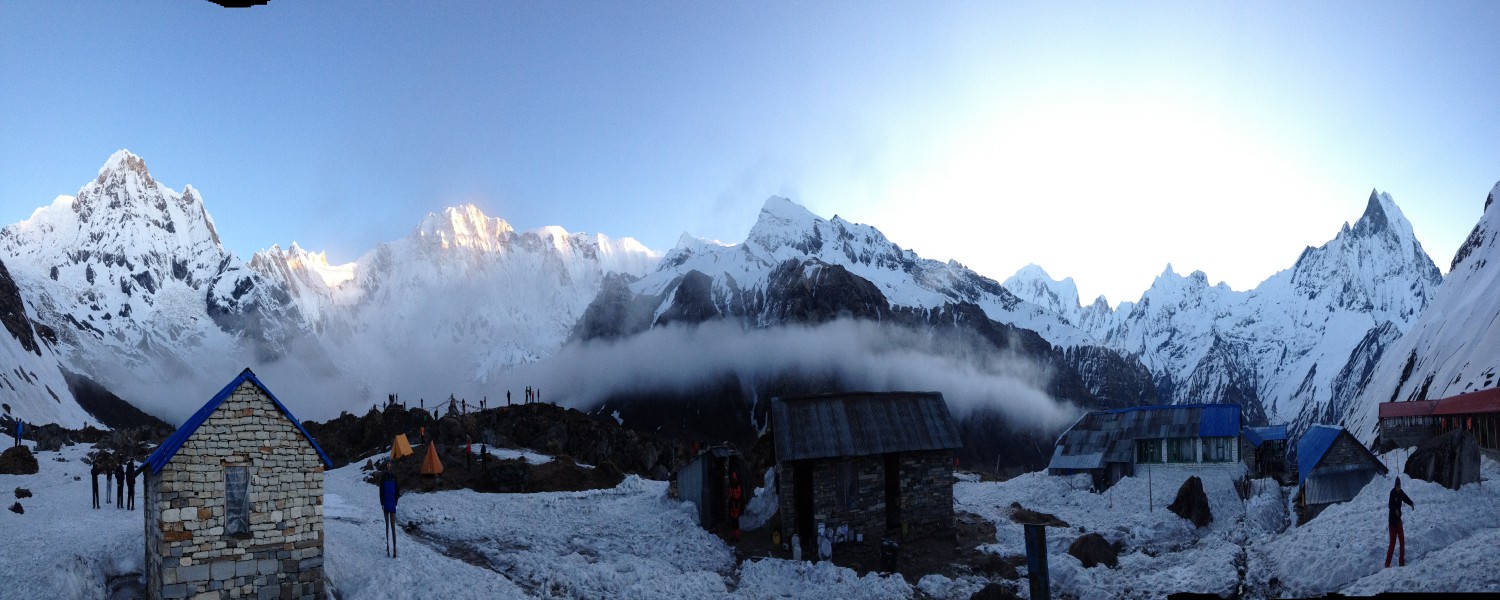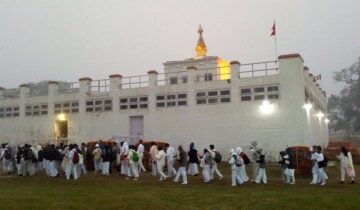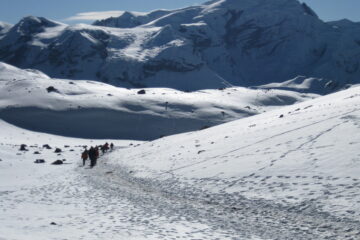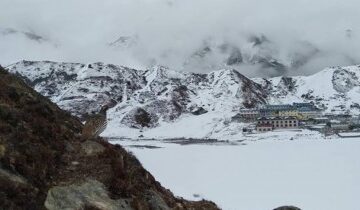“Quickest and a complete trek to reach Annapurna Base Camp viewing the spectacular Annapurna I (8091 m), Annapurna South (7219 m), Machapuchhre (6993 m) and Hiunchuli (6441)”
Annapurna is the most popular trekking region of Nepal and encounters by 50% and above tourists every year. The beautiful landscapes, the gorgeous mountain views, dense vegetation of rhododendrons, bamboos and giant firs throughout the trial are luring beauties of the trek. Apart from these, the rock-strewn steep trails, rushing rivers, deep waterfalls and the exceptionally unique cultural practices in the villages mostly dominated by Gurung inhabitants is equally worthwhile to explore. As the trek comes closer to the Annapurna Base Camp the improving views of the wide range of the Himalayas and the cool Himalayan breeze provides the sensational joys. Every moment the trek rewards with the worthwhile watch. It may be culture, landscapes or the pleasant weather. Annapurna Conservation Area Project has the lead role in preserving the floras, faunas, wild lives, and fragile nature of the region. The conserved area includes both the Base Camps Machapucchre and Annapurna. The trek in the region is also particularly popular because the trial also takes you the famous trekking peaks of Nepal including Tent Peak, Fluted Peak, and Hiunchuli.
Outline Itinerary
Day 01 Drive to Kimche and trek to Ghandruk (Altitude: 1940m/6360 ft. Drive: 2 and a half hrs. Trek: 2/3 hrs. Meal: BLD)
Day 02 Trek to Chhomrong (Altitude: 2170m/7120ft Trek: 5 – 6 hrs. Meal: BLD)
Day 03 Trek to Deurali (Altitude: 3,230m/10,597ft Trek: 5/6 hrs. Meal: BLD)
Day 04 Trek to Annapurna Base Camp via Macchapuchre base Camp (Altitude: MBC: 3700m/12135ft and ABC: 4,130m/13,545ft; Trek: 5-6 hours; Meal: BLD)
Day 05 Trek to Bamboo or Sinwa (Altitude: 2310m/7578ft; Trek: 7-8 hours; Meal: BLD)
Day 06 Trek to Kyumi, drive back to Pokhara (Altitude: 1,780m/5,859 ft. Trek: 5-6 hrs. Meal: BLD)
Trip Notes:
Quick Annapurna Base Camp Trek starts/ends at Pokhara and is based on T-House Trek. It includes Accommodation during the trek with all meals; Trekking Guide and helping staff (2:1). For any customization on the trip including preferable services, please contact us
Day 1: Drive to Kimche, trek to Ghandurk (Altitude: 1940m/6360 ft. Drive: 2 and a half hrs. Trek: 2/3 hrs. Meal: BLD)+
After Breakfast, our guide will meet you at the hotel. Starting of treks days with a drive towards Kimche following the Modi River. Driving along with off road from Birethanti will end at Kimche. Here, you can rest for a while and start to trek toward Ghandurk. Walking up through the stone steps through the forest, you will reach a beautiful village mostly inhabited by the Gurung community, is Ghandurk. Overnight at local lodge.
Day 2: Trek to Chhomrong (Altitude: 2170m/7120ft Trek: 5 - 6 hrs. Meal: BLD)+
Enjoying wonderful views of Himalayas and taking a delightful Gurung breakfast, you will start walking along the steep downhill to the Kimrong River through the forest of Oaks and Rhododendron, taking the closest view of Annapurna South and Fishtail. Afterward, crossing a suspension bridge, follow the smooth trail till Gurung village. Climb uphill trail for a while to reach the top of the ridge that joins the route to Chhomrong. It is the last village settle by the Gurung ethnic tribe as well as an entrance for a Sanctuary. Stay overnight at the local lodge.
Day 3: Trek to Deurali (Altitude: 3,230m/10,597ft Trek: 5/6 hrs. Meal: BLD)+
Following beautiful forest of Rhododendron to Kuldhihar, and walking in an easy downhill, you will reach the Bamboo, and then the trail continues passing through a dark bamboo forest, you will gently ascend in a slightly steep path. Just reaching Himalaya Hotel, the forest gets thinner and you can view the glacial river underneath. Climbing steeply up for a while on a rocky trail through the forest, you will reach Hinko cave. From here, you will encounter several gorges and avalanche track till Daurali. Overnight at Deurali local lodge.
Day 4: Trek to Annapurna Base Camp via Macchapuchre base Camp (Altitude: MBC: 3700m/12135ft and ABC: 4,130m/13,545ft; Trek: 5-6 hours; Meal: BLD)+
Today will be an interesting walk leading you toward ultimate destination of this trek. You will climb gently through a river bed then over a steep trail to the mountainside. The hike from Bagar to Machhapuchhre Base Camp will be a bit strenuous, however, you can get excellent views of the magnificent Machhapuchhre, and surrounding mountains including Mt. Hiunchuli, Annapurna South, Annapurna I, Annapurna III, Gandharvachuli, and Gangapurna. Spending time for a while, you will follow the trail to ABC. It will be a short but exciting walk in a fairly gentle ascent trail to Annapurna South Base Camp. Impressive views of the picturesque landscape and the snowcapped Himalayas surrounding you really feel amazing. The sanctuary boasts of a dynamic view without anything impeding the 360-degree panorama. Overnight at Annapurna Base Camp.
Day 5: Trek to Bamboo or Sinwa (Altitude: 2310m/7578ft; Trek: 7-8 hours; Meal: BLD)+
Spend your time enjoying sunrise view over the Himalayas, then retrace your journey back to Bamboo. It will be the steep downhill walk passing through the forest to the lodge at Bamboo. Take rest and enjoy the refreshing surrounding. Overnight at local lodge.
Day 6: Trek to Kyumi, drive back to Pokhara (Altitude: 1,780m/5,859 ft. Trek: 5-6 hrs. Meal: BLD)+
Today, you will have a short climb to Khuldi Ghar and retract to Sinuwa hill, hereafter you will follow long downhill to the Chhomrong Khola and continue to trek up to the Chhomrong. After a lunch break, trek steeply descends towards the Jhinu Danda. Here, you will stay for a while and starts walking towards Kyumi. It is a roadside station from where you can catch a vehicle to retrace back to Pokhara. Take rest and relax with a hot shower in Hotel. Overnight at Hotel.
Service Includes:
5 Nights’ accommodation at well and comfortable Mountain Lodge available en-route during the trek (Few nights’ at during trek with attached bathroom/toilets)
Full board meal during the trek (Breakfast, Lunch, Dinner, tea & coffee, seasonal fruits, chocolate/s & biscuits)
English speaking, First Aid and Eco-trained local trekking guide, Assistance guide as per the group size, porters (2:1)
All the expenses for guide and porters along with Insurance
Trek transfer as per the itinerary in a private vehicle
Annapurna Conservation Area Project (ACAP) fee
Exclusive medical kit bag, Duffle Bag, Trekking T-shirt
All government and local taxes as applicable
Service Excludes:
Nepal Visa – (Cost- US$- 30 for 15 days & $- 50 for 30 days)
Kathmandu and Pokhara accommodation and other services- shall be booked the accommodation on a suggestion
Travel insurance
Cost of personal nature expenses, Beverages (Mineral water or coca cola), cost of extra meals, snacks, phones bills, Internet, WiFi, laundry etc.
Cost incurred during the emergency, evacuations
Tips for Guide and porters
Nepal Visa & Getting into Nepal
All the foreign nationals (except Indian nationals) are required to display Visa while entering Nepal. Nepalese Visa can be obtained either at Nepalese Embassy of respective country or can be obtained during your arrival at the International Airport in Kathmandu or from Nepal’s border entry point. However, certain nationals are requested to arrange Visa prior to arrival in Nepal. The listed countries are- Afghanistan, Iraq, Cameroon, Ghana, Somalia, Swaziland, Palestine, Zimbabwe, Nigeria, Ethiopia, and Liberia and cannot secure Nepalese Visa on arrival.
Requirements: Traveler should have a valid passport for at least six months, recent digital photos (size: 1.5″ x 1.5″) and Visa fees (either US$ or equivalent) mentioned as below:
Visa Facility Duration Fee
Multiple entry 15 days US$ 30 or equivalent Nepalese currency
Multiple entry 30 days US$ 50 or equivalent Nepalese currency
Multiple entry 90 days US$ 125 or equivalent Nepalese currency
You can also download VISA form and fill up. Please go through the link as below:
http://www.online.nepalimmigration.gov.np/tourist-visa
Group Size:
For the group, we normally run with minimum 2 people to maximum 10 in our published group departure program. However, there is no barrier for a private trip. We can run a trip for a single person and even more than 10 in a group. Normally for a group, we provide 1 main guide, 1 assistance guide along with 1 porter for every 2 trekkers. Moreover, for every additional 2 trekkers, 1 more assistance and a porter will be provided making a team combination as follows:
Minimum to 2 PAX: 1 Guide and 1 porter
4-6 PAX: 1 guide, 1 assistance guide, and 3 porter
7-10 PAX: 1 guide, 2 assistance guide, and 4/5 Porter
Guide and Trip Safety
Once, you confirm your trip, it is our responsibility to make your trip wonderful without creating any difficulties. Hence, we have prepared our itinerary in such a way that it will properly acclimatize you. Also, we request you in advance to have regular exercises and make habits to walk on a daily basis. Similarly, during the trek, you will be fully guided by our professional trekking guides and support team. They are properly trained in regards to safety and first aid. Even, we have every set up in case of emergencies such as high altitude medicine and Gamow Bag (High altitude Chamber bag). Please note High altitude Chamber Bag is used to provide heat in your body and it is available at certain cost. Moreover, to let you familiar with altitude, you are suggested to walk slow and steady and ensure for proper acclimatization.
For trekking, we provide local experienced guide speaking fluent English and familiar with the local routes, landscape, flora, fauna as well as culture, and tradition of certain areas and let you feel comfortable. We do not encourage child labor, hence, our porter will be above 16 years that are living in the Himalayas of Nepal; as well as carries only 20-22 kg weight per porter. Normally, the guide and support teams are selected with proper analyzing of their experience, leadership skills, and personal aptitude. Our guides are well familiar with different societies of all caste and customs along the trail and share the insight culture with you that is not even noted in a guidebook.
To make our staffs more fluent and experienced, we consistently provide training. They have been participating in special training programs like Trekking guide training, Rock climbing, Ice climbing, Intensive Wilderness First Aid and many more that have been certified and approved by Nepal Government.
Meals and Accommodation
During your stay in Kathmandu, we accommodate you in 3-star category hotel in a comfortable and relaxing environment. Breakfast is included with room accommodation. Normally, based on your group size, you will be accommodated in twin and triple sharing basis. Likewise, in the case of the single room stay in a group, you will require to pay a single supplement charge mentioned in our trip cost. Also, if you wish to upgrade hotel accommodation, we can accommodate you in respective hotels with surcharge. On your arrival in Kathmandu and a day before your departure for a homeland, we Hiking Nepal Team will invite you for Welcome and Farewell dinner. You will be taken to an authentic restaurant serving Nepali Cuisine with some cultural Dance Show. For your other day’s meals, you can get hygienic restaurants providing verities of taste including continental, Chinese, Italian, Nepalese and many more.
Similarly, for your stay during the trek, we shall accommodate you in local lodge available en-route. Normally, the rooms are basic and on a twin sharing basis. Some lodges offer shower system and hot water.
For meals, you will be served with sufficient hygienic food. Our service includes a full board meal (Breakfast, Lunch, Dinner and Tea/Coffee) based on lodge menu. Normally, for breakfast; porridge, cereals, toast or chapattis, omelets and a range of hot drinks are served. Likewise for Lunch and Dinner; you can taste some Nepalese food (esp. rice, lentils, and curry), Sherpa food, Indian food, Italian Spaghetti, noodles, potatoes, even Pizza in some areas. It is obvious that you will receive fresh and organic food in the Himalayas of Nepal. Your breakfast and dinner will be served in a lodge where you stay and lunch on the way during the trek.
Travel Insurance
While traveling to Nepal, you are requested to have a travel insurance that should cover any comprehensive expenses possible to acquire due to medical issues or accidents. Especially, your travel insurance must protect air ambulance, treatment charges, rescue and evacuation, product cancellation and refundable charges, flight delay, and cancellations. We suggest you bring your travel insurance certificate or send us scan copy and required to issue from your homeland and we do not arrange or sell insurance.
Traveling in the Himalayas is full of adventurous; hence it is wise to choose a proper insurance policy. While choosing your insurance policy, make sure that it will protect all such unforeseen expenses. Your insurer should be well familiar with our itinerary that you have booked and must have agreed to cover all activities being undertaken during the trip. Meantime, it is not compulsory that our all the assigned trip are facilities with Heli-rescue.
Vaccination
It is better to follow the precaution given by World Health Organization and other international health-related institutions that recommend having vaccines before traveling Nepal to prevent from certain fatal illness. If possible, we suggest you bring your medical certificate however, it is not required to show but for safety. The recommended vaccines are polio, Diphtheria, Tetanus, typhoid, yellow fever, hepatitis A/B, Influenza (Flu), Japanese encephalitis, and Tuberculosis. Meantime, it is better to consult your professional doctor about your travel and he might recommend you properly. You can also take the suggestion of local travelers who have traveled Nepal before and know more about the required precautions. Please note that the protection that can be gained from vaccines varies from 50% to almost 100%. So remember that even if you have taken a vaccine you might still get the disease, although you will have greatly reduced your chances of getting ill.
Guide and Trip Safety
Once, you confirm your trip, it is our responsibility to make your trip wonderful without creating any difficulties. Hence, we have prepared our itinerary in such a way that it will properly acclimatize you. Also, we request you in advance to have regular exercises and make habits to walk on a daily basis. Similarly, during the trek, you will be fully guided by our professional trekking guides and support team. They are properly trained in regards to safety and first aid. Even, we have every set up in case of the emergency such as high altitude medicine and Gamow Bag (High altitude Chamber bag)- will charge the additional cost. Please note High altitude Chamber Bag is used to provide heat in your body and it is available at certain cost. Moreover, to let you familiar with altitude, you are suggested to walk slow and steady and ensure for proper acclimatization.
For trekking, we provide local experienced guide speaking fluent English and familiar with the local routes, landscape, flora, fauna as well as culture, and tradition of certain areas and let you feel comfortable. We do not encourage child labor, hence, our porter will be above 16 years that are living in the Himalayas of Nepal; as well as carries only 20-22 kg weight per porter. Normally, the guide and support teams are selected with proper analyzing of their experience, leadership skills, and personal aptitude. Our guides are well familiar with different societies of all caste and customs along the trail and share the insight culture with you that is not even noted in the guidebook. To make our staffs more fluent and experienced, we consistently provide training. They have been participating in special training programs like Trekking guide training, Rock climbing, Ice climbing, Intensive Wilderness First Aid and many more that have been certified and approved by Nepal Government.
Health and Fitness
While Trekking in the Himalayas of Nepal, you will be hiking up in high altitude, hence slow and steady is the main concern which helps you to acclimatize properly with the altitude. During trekking, you will require to walk for 5-6 hours on average. If you are planning to trek in Nepal, make sure that you are in good shape and fitness, and consult your doctor or general physicians about your health. You should be physically and mentally prepared. Before commencing a trek, we recommend you to do some regular exercises, make habits to use stairs than the elevator that makes your knees strong, and, if possible, join some aerobics, gyms and make sure about your good health. If you are used to with these habits, you will definitely walk in the Himalayas of Nepal. Sincere preparation and strong determination for the trip are very important for making your trip a wonderful memory of your life. It is not compulsory to have any previous experience. Follow the guidance and enjoy the trip.
High Altitude Sickness
At the higher altitude, you will feel a decrease in availability of oxygen and shorten in oxygen cause an altitude sickness. If a person walks in the high altitude particularly climbs up too quickly, he might suffer from High altitude sickness. Hence, proper rest is required at that altitude. You can cure at right time knowing certain symptoms of Altitude Sickness. Common symptoms are a headache, loss of appetite, tiredness and nausea, vomiting, dizziness and difficulty in sleeping. The best remedies that local belief and take is taking garlic, or ginger in the mouth. Eat dry food and take liquid as much as possible. We recommend Diamox if there are no any options. Also, we provide experienced guide and staffs in dealing with the effects of higher altitudes. As they are natives of Nepal, they easily acclimatize and therefore can care for their clients. They are equipped with necessary medical supplies and will assist with basic first aid treatment. We design our tours to ensure clients are ready for high altitude and arrange alternative itineraries for those at risk.
Acclimatization
While, trekking in the Himalayas, you will walk in the Ups down trail taking you to the elevation over 2500 m. Hence, you might feel difficult to breathe or your breathing speed up. Hence, it is most important to familiarize with the altitude and let you adjust with the decreased availability of oxygen at high altitude. Our itinerary is designed with sufficient days to acclimatize. In case of gaining certain height, there is a rest day when you can explore the area as well as walk to high altitude and sleep on low land. Likewise, you are suggested to walk slowly and carefully without getting any stresses. Also, for proper acclimatization, you should care about your eating habits. Don’t focus on Junk food and eat as much liquid as possible. Hard drinks are not recommended. The right way to acclimatize properly is to walk high, sleep low.
Diamox (Acetazolamide)
Diamox, mostly recognized drugs for altitude sickness prevention and treatment. It allows you to breathe faster so that you metabolize more oxygen, thereby minimizing the symptoms caused by poor oxygenation. This is especially helpful at night when respiratory drive is decreased. While using a Diamox, it is advisable to start taking it 24 hours before you go to altitude and continue for at least five days at higher altitude. The recommendation of the Himalayan Rescue Association Medical Clinic is 125 mg. twice a day (morning and night). (The standard dose was 250 mg. but their research showed no difference for most people with the lower dose, although some individuals may need 250 mg.) Possible side effects include tingling of the lips and fingertips, blurring of vision, and alteration of taste. These side effects may be reduced with the 125 mg. dose. Side effects subside when the drug is stopped. It is more appropriate to contact your physician for a prescription. Since Diamox is a sulfonamide drug, people who are allergic to sulfa drugs should not take Diamox. Diamox has also been known to cause severe allergic reactions to people with no previous history of Diamox or sulfa allergies. Frank Hubbell of SOLO recommends a trial course of the drug before going to a remote location where a severe allergic reaction could prove difficult to treat.
Highly recommended to take a trial course before going to a remote location where a severe allergic reaction could prove difficult to treat if it occurred.
Alternative Drugs:
Dexamethasone (a steroid) is also a prescribed drug that decreases brain and other swelling reversing the effects of AMS. The dose is typically 4 mg twice a day for a few days starting with the ascent. This prevents most of the symptoms of altitude illness from developing.
ADVICE:
Dexamethasone is a powerful drug and should be used with caution and only on the advice of a physician and should only be used to aid acclimatization by sufficiently qualified persons or those with the necessary experience of its use.
NOTE:
It is more advisable to take drugs taking proper suggestions from Personal Physicians and in case if there are no any options. In the Himalayas of Nepal, the mountain dwellers believe in taking some garlic or ginger along with Red Pepper to produce heat for fast breathing.
| Start Date | Trip Price | Action |
|---|






Tour Reviews
There are no reviews yet.
Leave a Review